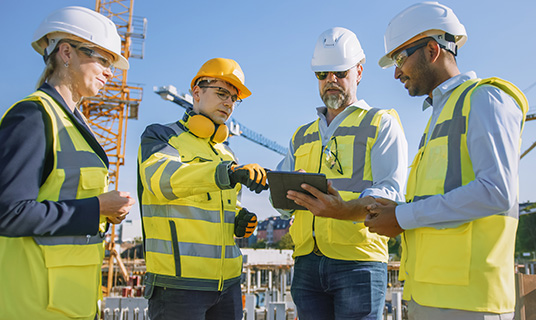Five ways procurement can improve building safety
SWPA is the South West regional hub of LHC, our public sector clients, appointed companies, and partners benefit from our expertise as well as the knowledge and expertise from the wider company.
The political spotlight has remained firmly fixed on building safety in the first half of 2022. While progress towards the Hackitt Review recommendations is slowly being made, there is a continued need to revisit and reform processes at procurement level and through the whole supply chain.
Taken in conjunction with the new Building Safety Act 2022, the ‘Guidance on Collaborative Procurement for Design and Construction to support Building Safety’, published by Professor David Mosey at the start of this year, provides clarity on how procurement practices can improve building safety at both root and branch.
LHC has been working with clients, suppliers and stakeholders to look at how collaborative frameworks can improve safety from procurement, through to design, construction and beyond. We recently discussed this issue in our film, ‘Collaborating to achieve the Gold Standard’, with appointed company Novus Property Solutions.
Here is a recap on the key principles from the guidance for producing safer, better-quality built environment outcomes through reduction of risk and improved value.
- Use of two stage tendering
Mosey’s collaborative procurement guidance encourages framework providers to use a two-stage procurement process, with assessment measures beyond price. This means adopting a true values-based approach, considering outcomes for both society and the environment.
Criteria for assessing potential suppliers’ competencies should be consistent, measurable and clearly weighted. This means ruling out single-stage, fixed-price processes where pricing can be inaccurate, bidders having to factor unknowns into their pricing and potentially leading to problems such as disputes or project delays.
LHC supports the use of a two-stage processes, having an initial tender exercise to appoint a contractor, then allowing further exploration and discussion about the project scope, conditions and challenges before reaching a more informed fixed value. This can help to reduce contractor risks, allow involvement of supply chain and subcontractors and identify added value or cost reduction without impacting quality.
- Looking beyond lowest cost
To avoid a race to the bottom, the paper recommends structuring procurement to favour quality and emphasises the importance of having a clear brief and success measures in place from the outset. The evaluation criteria should be clearly linked to this – a point supported by the ‘value-based procurement’ approach set out in the Construction Playbook.
In addition, the guidance highlights the need for pricing models that consider more than just a single fixed price, to avoid the common issue of low-price, low-quality bids coming out on top after assessment.
- Involving supply chain earlier
The guidance is crystal clear on the importance of early supply chain involvement (ESI) for reducing risk and improving safety. Once again, it advocates for use of a value-based process in appointing principal contractors, subcontractors and wider supply chain.
ESI is also underlined for its pre-construction role in testing how framework alliances can work together in practice. This helps reduce risk, improve project outcomes, increase cost certainty and transparency, and to plan and agree timescales.
- Using the right systems
Systems promoting use of a digital golden thread play a vital part in procurement and helping to promote a collaborative culture in a framework. This also helps to tackle disputes early and means cost information and pricing can be recorded accurately.
The guidance is clear that digital information management systems should be used to integrate design, construction, and operation within frameworks, to share, create and store project information, and improve whole-life asset management. Alongside this, BIM is also essential for improving collaborative procurement relationships and ESI.
- Improving safety through collaborative methods
Strategic collaboration is earmarked in a number of ways for its place in improving systemic safety. Framework alliances can be brought together in a number of ways, such as through the use of an FAC-1 contract LHC also uses. These collaborative tools help align providers, contractors, subcontractors, and suppliers under one set of objectives, measurements and abiding principles.
Alliances can cover whole-life asset management, bringing the safety of building users into central focus from the outset of a framework.
Professor Mosey also singles out new and more collaborative approaches to construction, such as MMC, for their ability to boost safety and yield other benefits such as energy efficiency and circular economy contributions.
- Improving economic, social and environmental value
The end goal of better, more collaborative procurement processes should always be to produce improved economic, social and environmental value – with reduced risk and improved safety an overarching objective.
By implementing the four above points, overall value improves for clients and wider programme, as well as local communities and businesses. LHC has seen clear benefits in measuring social and environmental value from assessment to outcomes, finding improved cost certainty and safety is often also realised at the same time.
While there is no legal status attached to ‘Guidance on Collaborative Procurement for Design and Construction to support Building Safety’ itself, its principles are a culmination of the central points from documents released since the Construction Playbook in 2020, many of the outcomes now enshrined in law through the Building Safety Act 2022.


